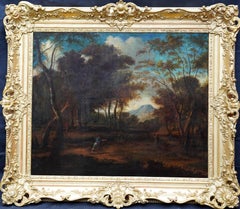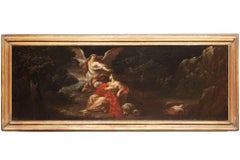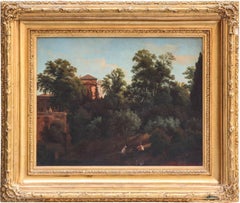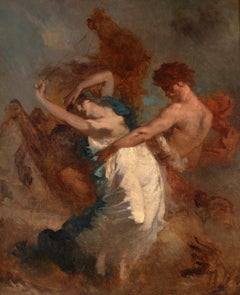Jean François Millet Paintings
to
1
Overall Width
to
Overall Height
to
1
1
1
1
1
6
781
718
706
692
1
1
Artist: Jean François Millet
Diana Hunting in Wooded Landscape - 17thC Old Master French art oil painting
By Jean François Millet
Located in Hagley, England
This superb French Old Master oil painting with excellent provenance is by Jean Francois I Millet. It was painted circa 1675 and is a figurative landscape depicting Diana hunting in ...
Category
17th Century Old Masters Jean François Millet Paintings
Materials
Oil
Related Items
17th Century by Felice Torelli Hagar and the Angel Oil on Canvas
Located in Milano, Lombardia
Felice Torelli (Verona, Italy, 1667 - Bologna, Italy, 1748)
Title: Hagar and the Angel
Medium: Oil on canvas
Dimensions: without frame 41 x 116 cm - wit...
Category
Late 17th Century Old Masters Jean François Millet Paintings
Materials
Cotton Canvas, Canvas, Oil
$18,022 Sale Price
20% Off
H 20.67 in W 50.01 in D 1.97 in
19th Century Roman Landscape oil on canvas with Giltwood Frame
Located in Rome, IT
Amaizing 19' century Roman landscape depicting a part of Villa Borghese with Trinità dei Monti.
With a finely carved gilt wood coeval frame.
Measurements with frame cm 65 x78 wit...
Category
19th Century Old Masters Jean François Millet Paintings
Materials
Oil
$5,334
H 25.6 in W 30.71 in D 1.97 in
View of Ponte Milvio in Rome
Located in Roma, RM
Northern painter active in Rome in the second half of the 17th century, View of Ponte Milvio
Oil painting on canvas 73 x 97 cm in coeval Roman Salvator Rosa frame.
Category
18th Century and Earlier Old Masters Jean François Millet Paintings
Materials
Canvas, Oil
18th Century By Giustino Menescardi Ascent to Calvary Oil on Canvas
Located in Milano, Lombardia
Giustino Menescardi (Milan, Italy, c. 1720 - Venice, Italy, after 1779)
Title: Ascent of Calvary
Medium: Oil on canvas
Dimensions: without frame 47 x 36 cm - with frame 57 x 43 cm
Shaped and gilded wooden cassetta frame
Publications:
Bozzetti, modelletti, sketches: dalla collezione di Giorgio Baratti...
Category
Early 18th Century Old Masters Jean François Millet Paintings
Materials
Cotton Canvas, Canvas, Oil
$12,139 Sale Price
22% Off
H 18.51 in W 14.18 in D 1.97 in
Macbeth and the Three Witches a Painting on Panel by Francesco Zuccarelli
By Francesco Zuccarelli
Located in PARIS, FR
This painting, created during Zuccarelli's stay in England, represents the decisive moment when Macbeth, together with Banquo, meets the three witches who announce that he will be Ki...
Category
1760s Old Masters Jean François Millet Paintings
Materials
Oil, Wood Panel
$55,000
H 17.33 in W 22.05 in
19th Century Roman Landscape oil on canvas with Giltwood Frame
Located in Rome, IT
Amaizing 19' century Roman landscape depicting a part of Villa Borghese with Trinità dei Monti.
With a finely carved gilt wood coeval frame.
Measurements with frame cm 65 x78 wit...
Category
19th Century Old Masters Jean François Millet Paintings
Materials
Oil
$5,334
H 25.6 in W 30.71 in D 1.97 in
17th Century by Felice Torelli Rachel Hiding the Idols Oil on Canvas
Located in Milano, Lombardia
Felice Torelli (Verona, Italy, 1667 - Bologna, Italy, 1748)
Title: Rachel Hiding the Idols
Medium: Oil on canvas
Dimensions: without frame 41 x 116 cm -...
Category
Late 17th Century Old Masters Jean François Millet Paintings
Materials
Canvas, Cotton Canvas, Oil
$15,412 Sale Price
20% Off
H 20.67 in W 50.01 in D 1.97 in
17th Century by Jacob de Heusch Pair of Landscapes Oil on Canvas
Located in Milano, Lombardia
Jacob De Heusch (Utrecht, Netherlands, 1657 – Amsterdam, Netherlands, 1701)
Title: Pair of Landscapes
Medium: Oil on canvas
Dimensions: without frame 50 x 8...
Category
17th Century Old Masters Jean François Millet Paintings
Materials
Oil, Canvas
$48,370 Sale Price
20% Off
H 19.69 in W 31.5 in
Stag Hunting in the Vicinity of Nuremberg by a German Artist Peter von Bemmel
Located in PARIS, FR
This small landscape shows a hunting scene: two riders are chasing a stag with their dogs at the edge of a forest. Signed by Peter von Bemmel, it is typical of the production of this...
Category
1720s Old Masters Jean François Millet Paintings
Materials
Copper
18th Century by Antonio Stom Architectural Capriccio Oil on Canvas_
By Antonio Stom
Located in Milano, Lombardia
Antonio Stom (Venice, Italy, c. 1688 - 1734)
Title: Architectural Capriccio
Medium: Oil on canvas
Dimensions: without frame 88 x 113 cm - with frame 106 x 132 cm
Carved, sculpted and...
Category
Early 18th Century Old Masters Jean François Millet Paintings
Materials
Canvas, Oil, Cotton Canvas
$18,968 Sale Price
28% Off
H 34.65 in W 44.49 in D 1.97 in
17th Century by Giovan Battista Discepoli Coronation of Thorns Oil on Panel
Located in Milano, Lombardia
Giovan Battista Discepoli, also called the "Zoppo from Lugano" [Castagnola (Lugano), Switzerland, 1590 - Lugano, Switzerland, 1654]
Title: Coronation of Thorns
Medium: Oil on panel
D...
Category
Early 17th Century Old Masters Jean François Millet Paintings
Materials
Panel, Oil
$29,638 Sale Price
20% Off
H 13.47 in W 15.56 in D 1.97 in
17th Century by Pieter Mulier Landscape Oil on Canvas
By Pieter Mulier known as the Cavalier Tempesta (Haarlem 1637 - Milan 1701)
Located in Milano, Lombardia
Pieter Mulier known as Tempesta (Haarlem, Netherland, 1637 - Milan, Italy, 1701)
Title: Landscape
Medium: Oil on canvas
Dimensions: without frame 49 x 65...
Category
17th Century Old Masters Jean François Millet Paintings
Materials
Canvas, Oil, Cotton Canvas
$12,709 Sale Price
22% Off
H 19.49 in W 25.79 in D 1.97 in
Previously Available Items
The Abduction of the Sabine Women
By Jean François Millet
Located in New Orleans, LA
This dynamic oil on canvas represents one of the most recognized subjects of art history by one of the most important artists of the 19th century. Entitled The Abduction of the Sabine Women, it was composed by the great Jean-François Millet, a painter who is rightfully celebrated as the master of the peasant. Rather than a sower or field laborer, however, this early work captures a mythological narrative, a remarkable rarity for this painter. The dramatic story lends Millet the opportunity to display his command of figure, gesture and tone, revealing the earliest hints of the Realist style that would come to define his artistic genius.
This tempestuous scene of a woman being abducted by a man on horseback was composed at a critical point in Millet’s career. After studying at the École des Beaux-Arts under the tutelage of the history painter Paul Delaroche, Millet achieved modest success as a portrait and genre painter. Yet, by the 1840s, he sought to establish himself on a larger stage and began working on classical and historical compositions for the Paris Salon with emphasis on the human figure. The Abduction of the Sabine Women is among his finest compositions during this important period.
The narrative refers to an incident in Roman mythology when Roman men abducted women from a neighboring region — known as the Sabines — to take as wives. Under the direction of their founder Romulus, the Romans sought to form peaceful alliances with their neighbors and formally requested the rights of marriage with neighboring tribes. Rome's emissaries, however, were unsuccessful, so Romulus decided upon more drastic measures in order to ensure the security and future of his city. According to Levy, during the festival of Neptune Equester, the Romans successfully fought off the Sabine men and captured the young Sabine virgins, who they then married. Though the action initially resulted in war between the two nations, eventually peace was won thanks to the intervention of the Sabine women, who begged for unity between their families and their new husbands.
Throughout art history, The Abduction of the Sabine Women has been depicted by modern and old masters from Giambologna’s 16th-century marble sculpture to masterpieces in oil by Nicolas Poussin, Peter Paul Rubens, Jacques-Louis David and Pablo Picasso. Millet's treatment of the subject reveals his own influences, most specifically the great French Romantic painter Eugène Delacroix.
Although the subject pays homage to Jacques-Louis David’s Neoclassicism, Millet’s use of broad, quick brushstrokes and strong color notes of deep blue-greens and oranges displays a Romantic treatment. In assessing this painting, Millet expert Alexandra Murphy writes, “Only a few documented works survive from this period, and [the] painting is important as a reminder that Millet was looking to the example of Delacroix’s work even more than to his own master, Delaroche.”
Within a few years of creating the work, Millet turned to realistic subjects and moved to Barbizon, where he lived for the rest of his life. By the 1870s, the artist’s work was well established in Boston collections, but it wasn’t until the 1880s that Millet’s popularity spread to other parts of the country. In 1886, two important painting auctions took place in New York at the American Art Galleries: the sale of the Estate of Mrs. Charles Morgan...
Category
19th Century Realist Jean François Millet Paintings
Materials
Canvas, Oil
Jean François Millet paintings for sale on 1stDibs.
Find a wide variety of authentic Jean François Millet paintings available for sale on 1stDibs. You can also browse by medium to find art by Jean François Millet in oil paint, paint and more. Much of the original work by this artist or collective was created during the 18th century and earlier and is mostly associated with the Old Masters style. Not every interior allows for large Jean François Millet paintings, so small editions measuring 40 inches across are available. Customers who are interested in this artist might also find the work of Sir Godfrey Kneller, Studio of Sir Peter Lely, and Goyo Dominguez. Jean François Millet paintings prices can differ depending upon medium, time period and other attributes. On 1stDibs, the price for these items starts at $15,290 and tops out at $15,290, while the average work can sell for $15,290.
Artists Similar to Jean François Millet
Questions About Jean François Millet Paintings
- 1stDibs ExpertJanuary 27, 2025Jean-François Millet is famous because of his Realist artwork. One of the founders of the Barbizon school, he was a major force in the 19th-century French Realist art movement. He is best known for his depictions of rural people working in the fields, such as The Gleaners, The Angelus and Shepherdess with Her Flock. Shop a collection of Jean-François Millet art on 1stDibs.
- 1stDibs ExpertNovember 20, 2024One of the most famous Realism paintings made by Jean-François Millet is called The Gleaners. It depicts three peasant women working in a field. Millet produced the oil painting in 1857, and it is now part of the collections of the Musée d'Orsay in Paris, France. Other notable works by the French artist include The Angelus, Shepherdess with Her Flock and Man with a Hoe. On 1stDibs, explore a range of Jean-François Millet art.



